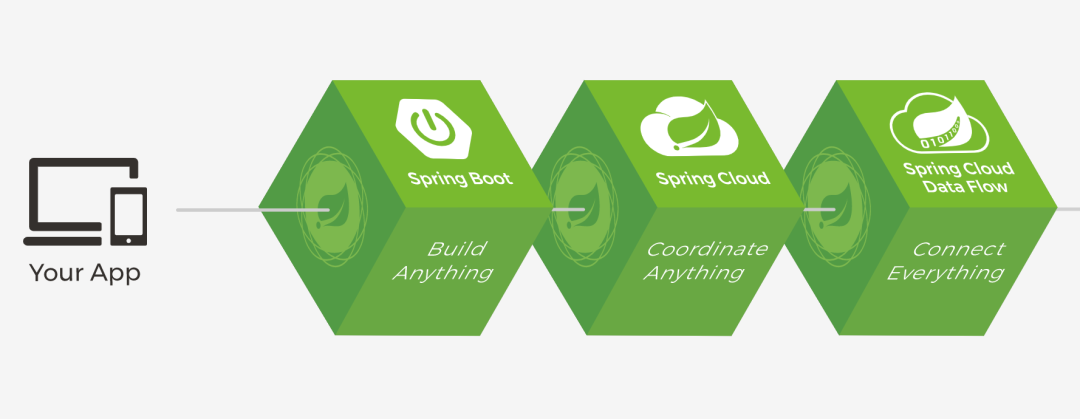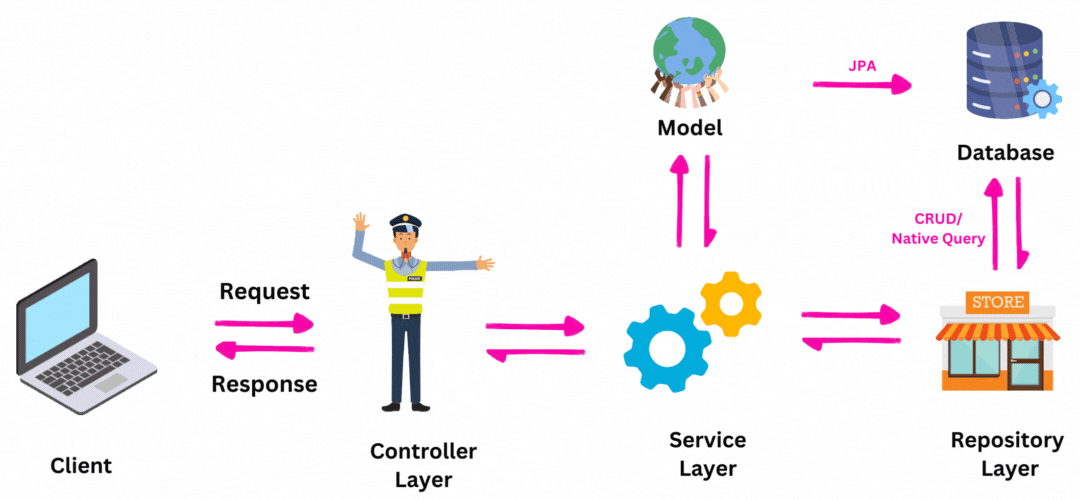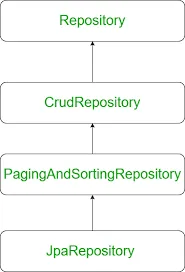本文的内容有助于理解Java Spring Boot框架的层次结构。
“我决定不让自己彻底崩溃,而是每个周二晚上都让自己小崩溃一下。” —— Graham Parke

检查任何软件的最好方法是将其分成层,然后将这些层合并在一起。我们在这里遵循同样的方法。
在深入研究Java Spring Boot之前,让我们先来看一个众所周知的例子——计算机网络中的OSI模型。虽然网络整体上看起来很复杂,但我们通常将其分成层次以组织协议。我们还声明每个层都依赖于下面一层提供的服务。在Spring Boot中,同样的原则也适用。
1 Spring Boot的层次结构

我们主要可以将Spring Boot分成四层:
1.1 控制器层
系统与客户端请求交互的第一部分是控制器。它们定义了API的端点,可以将端点想象为有效的路由和请求方法(GET、POST、PUT)。控制器的主要目标是向客户端提供服务,即提供响应、状态等。控制器利用服务层提供的服务来为客户端提供服务。
端点的示例:
- /login (POST)
- /register (POST)
- /products (GET)
1.2 服务层
服务层旨在实现业务逻辑。服务层的主要目的是向控制器层提供服务。所有对数据的计算都在这一层中执行,因此服务层需要数据。所以,它们依赖于DAO/Repository层提供的服务。
1.3 DAO/Repository层
DAO代表数据访问对象,这一层的主要目标是从数据库中高效地访问(查询)数据,并向服务层提供服务。

在Spring Boot中存在提供CRUD操作(创建、检索、更新、删除)的接口。因此,Repository层可以实现其中的一个。
1.4 模型层
模型表示现实世界中的对象,这些对象被称为模型。JPA(Java Persistence API)提供了关于ORM(对象关系映射)的参考或详细信息,这意味着Java类可以与数据库表相关联。在Spring Boot中存在许多JPA ORM的实现,其中之一是Hibernate。因此,您需要现实世界实体的Java类,然后将其映射到关系(表)中。
2 上述层次结构的实现模板
注意:对于实施,我们把项目管理作为一个主题。
2.1 控制器层:
ProjectController.java
package com.example.Controller;
//导入语句在此处
@RestController
public class UserController {
//列出所有可用项目
@GetMapping(path = "/projects", produces = MediaType.APPLICATION_JSON_VALUE)
public ResponseEntity<List<Project>> getProjects() {
// 执行验证检查
// 返回服务层提供的服务
}
//申请项目
@PostMapping(path = "/apply-project", consumes = MediaType.APPLICATION_JSON_VALUE)
public ResponseEntity<HttpStatus> applyProject(@RequestBody Map<String,String> json) {
// 执行验证检查
// 返回服务层提供的服务
}
//上传简历
@PostMapping(path = "/upload-resume/{usn}")
public ResponseEntity<List<Object>> uploadToDB(@RequestParam("file") MultipartFile[] file,@PathVariable String usn) {
// 执行验证检查
// 返回服务层提供的服务
}
//下载简历
@GetMapping("/files/download/{fileName:.+}")
public ResponseEntity downloadFromDB(@PathVariable String fileName) {
// 执行验证检查
// 返回服务层提供的服务
}
}上述示例使用了@注释,这些注释用于告知spring是否是RestController,PostMapping等。
2.2 服务层:
ProjectService.java
package com.example.Service;
// 导入语句
public interface ProjectService {
ResponseEntity<List<Project>> getProjects();
HttpStatus applyProject(String USN,int project_id);
ResponseEntity<List<Object>> uploadProjectDocument(MultipartFile[] files,int project_id);
}ProjectServiceImpl.Java
package com.example.Service;
//导入语句
@Service
public class ProjectServiceImpl implements ProjectService {
//将DAO进行依赖注入(Autowire)
@Override
public ResponseEntity<List<Project>> getProjects() {
try {
//利用DAO服务实现业务逻辑
} catch (Exception e) {
return new ResponseEntity<>(null,HttpStatus.INTERNAL_SERVER_ERROR) ;
}
}
@Override
public HttpStatus applyProject(String USN, int project_id) {
//利用DAO服务实现业务逻辑
}
//辅助函数
public ResponseEntity uploadToLocalFileSystem(MultipartFile file,int project_id) {
}
@Override
public ResponseEntity<List<Object>> uploadProjectDocument(MultipartFile[] files,int project_id) {
//利用DAO服务实现业务逻辑
}
}2.3 Repository/DAO层:
ProjectDAO.java
package com.example.Dao;
//导入语句
public interface ProjectDao extends JpaRepository<Project,Integer> {
//你也可以在JPA提供的CRUD操作之上包含本地查询
//使用@Query注释和相应的函数在此处添加查询
@Query(value = "Your SQL query ",nativeQuery = true)
public List<Project> getProjects();
}
}2.4 模型层:
Project.java
package com.example.Entity;
//导入语句
@Entity
@Table(name = "project")
public class Project {
@Id
@GeneratedValue(strategy = GenerationType.IDENTITY)
private int project_id;
@Column(nullable = false, name = "company_name")
private String company_name;
@Column(nullable = false, name = "description")
private String description;
@Column(nullable = false, name = "requirements")
private String requirements;
@Column(nullable = false, name = "manager")
private String manager;
@Column(nullable = false, name = "start_date")
private Date start_date = new Date();
@Column( name = "end_date")
private Date end_date = new Date();
@Column(nullable = false,name = "opening")
private int opening;
@Column(name = "resources")
private String resources;
public Set<Staff> getStaff_incharge() {
return staff_incharge;
}
public void setStaff_incharge(Set<Staff> staff_incharge) {
this.staff_incharge = staff_incharge;
}
public Set<Student> getApplied_students() {
return applied_students;
}
public Set<Document> getDocuments() {
return documents;
}
public void setDocuments(Set<Document> documents) {
this.documents = documents;
}
@JsonIgnore
@ManyToMany(mappedBy="funded_projects")
private Set<Fund> funds;
public Set<Fund> getFunds() {
return funds;
}
public void setFunds(Set<Fund> funds) {
this.funds = funds;
}
public void setApplied_students(Set<Student> applied_students) {
this.applied_students = applied_students;
}
public Set<Student> getWorking_students() {
return working_students;
}
public void setWorking_students(Set<Student> working_students) {
this.working_students = working_students;
}
//构造函数
public Project() {
super();
}
public Project(int project_id, String company_name, String description, String requirements, String manager, Date start_date, Date end_date, int opening, String resources) {
super();
this.project_id = project_id;
this.company_name = company_name;
this.description = description;
this.requirements = requirements;
this.manager = manager;
this.start_date = start_date;
this.end_date = end_date;
this.opening = opening;
this.resources = resources;
}
public int getProject_id() {
return project_id;
}
public void setProject_id(int project_id) {
this.project_id = project_id;
}
public String getCompany_name() {
return company_name;
}
public void setCompany_name(String company_name) {
this.company_name = company_name;
}
public String getDescription() {
return description;
}
public void setDescription(String description) {
this.description = description;
}
public String getRequirements() {
return requirements;
}
public void setRequirements(String requirements) {
this.requirements = requirements;
}
public String getManager() {
return manager;
}
public void setManager(String manager) {
this.manager = manager;
}
public Date getStart_date() {
return start_date;
}
public void setStart_date(Date start_date) {
this.start_date = start_date;
}
public Date getEnd_date() {
return end_date;
}
public void setEnd_date(Date end_date) {
this.end_date = end_date;
}
public int getOpening() {
return opening;
}
public void setOpening(int opening) {
this.opening = opening;
}
public String getResources() {
return resources;
}
public void setResources(String resources) {
this.resources = resources;
}
@Override
public String toString() {
return "Project{" +
"project_id=" + project_id +
", company_name='" + company_name + '\'' +
", descriptinotallow='" + description + '\'' +
", requirements='" + requirements + '\'' +
", manager='" + manager + '\'' +
", start_date=" + start_date +
", end_date=" + end_date +
", opening=" + opening +
", resources='" + resources + '\'' +
'}';
}
}在上面的示例中,该类表示一个表,其数据成员表示表的属性。我们还可以使用OneToOne、ManyToOne、ManyToMany注释表示表之间的关系。
上述实现是不完整的,因为本文的目的是了解工作流程和层次结构。Spring Boot非常庞大,本文只涵盖了其中的一小部分。如果本文有任何错误,在此深表歉意,希望对您有所帮助,谢谢!




































